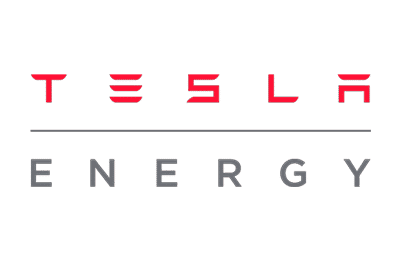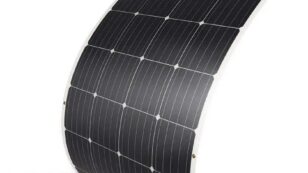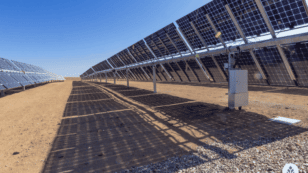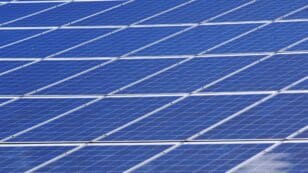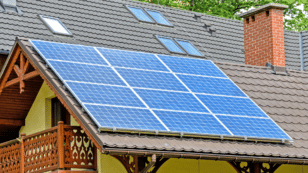
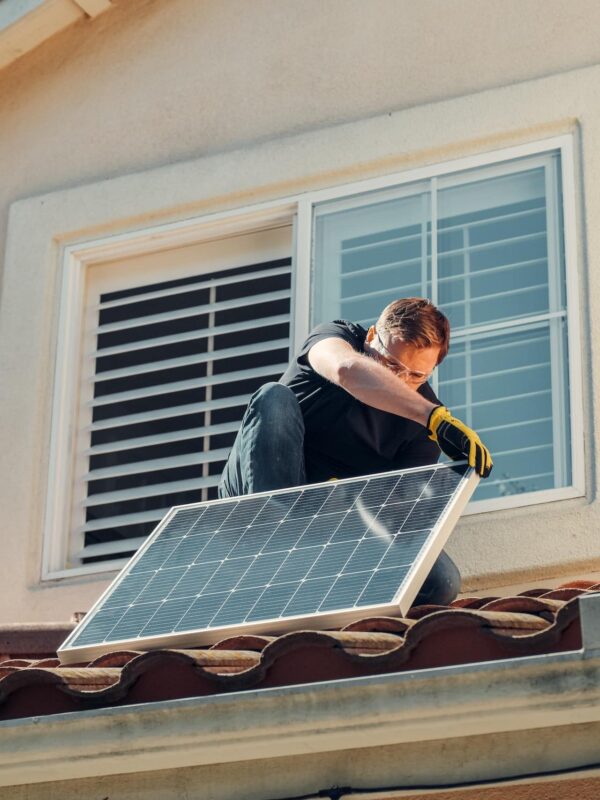
Top 5 Best Solar Batteries (2024 Costs & Reviews)
In this review of the best solar batteries, you’ll learn:
- Is the Powerwall actually the best solar battery?
- Cost isn’t the most important factor to consider – but what is?
- Should you get lithium-ion or lead-acid solar batteries?
Each product and or company featured here has been independently selected by the writer. You can learn more about our review methodology here. If you make a purchase using the links included, we may earn commission.
What Are the Best Solar Batteries?
If you’re looking for improved solar savings and blackout protection for your home, then adding a solar battery to your solar array is a great option. Most people know about the Tesla Powerwall, and while it’s a great product, it doesn’t mean it’s the best solar battery out there.
In this guide, we’ll be discussing what we believe are the top five best solar battery manufacturers to choose from for home solar power systems. These include the following:
- Tesla: Best Performance (Read more)
- Panasonic: Outstanding Value (Read more)
- SunPower: Best Availability (Read more)
- Generac: Most Efficient (Read more)
- LG: Best Customization Options (Read more)
We’ll explain why each is a great option for these purposes and help you decide which is the best one for your needs below. You can click on the drop-down menus under each battery option for more detailed information.

Tesla Energy
Pros
- Price-match guarantee
- Sleek, efficient and durable solar panels
- Best solar battery on the market
Cons
- Some reported issues with customer service
- Customer service varies by local dealer
Tesla is a leader in the industry in terms of technology, and the different Powerwall batteries are a clear reason why. The energy storage systems from Tesla are sleek, perform better than most other options on the market and come with some impressive technology that makes them super convenient to use. The high demand means the waitlist for products is quite long, but we feel they’re still some of the best options available.
We recommend Tesla solar batteries for homeowners who want the best of the best and don’t mind waiting a few months for supply to catch up with demand.
What We Like
There are so many positive things to say about Tesla’s solar batteries. First off, they’re expensive, but the cost per kilowatt-hour (kWh) is well below the industry average at just $851. In fact, they’re some of the most affordable backup batteries when taking capacity into account.
Tesla’s solar batteries have outstanding performance specifications. The capacity is above the industry standard—13.5 on the Powerwall+ as opposed to the typical 5.1 kWh—and they have the highest total capacity we’ve seen.
These are modular batteries, so you can connect 10 Powerwalls in series for a maximum storage capacity of 135 kWh. That means they should keep just about any home powered through a blackout, even if you have an above-average electricity consumption rate.
The batteries have an above-average peak output for high-demand homes. They have some impressive technology included at no cost, and they also come equipped with features like Storm Watch, which automatically recharges your batteries if severe weather is headed your way.
What We Don’t Like
The downside to buying a solar battery from Tesla is the delay you’re likely to experience between ordering and installation. Tesla’s competitors are likely running into the same supply chain issues, but they have a much lower demand for their products, so they can often be installed shortly after ordering.
Tesla has also been in the news in the past few years for social sustainability issues, including claims of racism in its production facilities. These claims haven’t been substantiated yet, but this is a potential negative to consider.
Read our full review of Tesla for more information.
Solar Battery Options
Tesla has two solar batteries in production: the Powerwall and the Powerwall+.
- Tesla Powerwall: The original Powerwall has a capacity of 13.5 kWh. The primary differences between it and the Powerwall Plus are the power output and the inverter. The original Powerwall has a 10 kWh peak output, which is less than half of what the Plus provides. This is also smaller than the other option, at 45 inches tall. It also notably does not include an islanding inverter.
- Tesla Powerwall+: The Powerwall+ has a peak output of 22 kWh when connected to the grid, which is well above the industry average and what the original Powerwall can handle. The Powerwall+ is much taller at nearly 63 inches. The islanding inverter included allows the battery to disconnect from and operate independently from the electric grid.
The table below includes a comparison of the two battery options from Tesla to help you decide which might be best for your home.
| Tesla Powerwall | Tesla Powerwall+ | |
| Storage Capacity (Per Battery) | 13.5 kWh | 13.5 kWh |
| Total Capacity (In Series) | 135 kWh | 135 kWh |
| Total Cost | $8,500 | $10,500 |
| Cost Per kWh | $629 | $851 |
| Continuous Power Output | 5 kWh | 7 kWh |
| Peak Power Output | 10 kWh | 9.7 kWh |
Warranty Information
Tesla’s battery warranty is close to the industry standard. The warranty term is 10 years, which is average, and the guaranteed remaining efficiency at the end of the warranty is 70%, which is just a touch below average.
Tesla has a good reputation for responding to warranty claims, so you’re unlikely to run into major issues if you do have a problem with your battery performance. On average, your Tesla battery should last a minimum of 10 years, but many customers find that they last 15 to 20 years.
Installation Options
Tesla Powerwalls cannot be purchased separately for a DIY installation, which is the case for most batteries on the market. Much like it does for its solar panels, the company uses a massive network of third-party installers to distribute and install its batteries, so you should have no problem finding an installer in your area to tackle the installation.
Tesla also recently started allowing battery installations independently of solar panels, so you can now have your Powerwalls installed as backup electric generators even if you don’t have a solar panel system on your roof. The best part is that you can still take solar incentives and rebates that apply.
Facts and Figures: Tesla Energy
| EcoWatch Rating |
|---|
| Better Business Bureau (BBB) Rating |
| Average Cost ($-$$$$$) |
| Solar Services |
| 4.5 |
| C |
| $$ |
| Solar Panels, Solar Batteries, EV Chargers, Solar Roof Shingles, System Monitoring |

Panasonic

Average cost
Pros
- Great for extreme temperatures
- Top-tier electronics company
- Competitively priced
- Durable panels
Cons
- Expensive
Panasonic is a major player in the industry, and its batteries are some of the best alternatives to the more well-known Powerwalls from Tesla. The batteries provide outstanding value for the money, with below-average pricing per kWh, some of the highest per-battery capacities in the industry and outstanding performance specifications.
Panasonic has a slightly below-average warranty, but we still think it’s a great option for anyone looking to get the most bang for their buck.
What We Like
Some of the best things about Panasonic’s solar batteries are the high capacity and the above-average performance specs. The Evervolt 2.0 battery has a massive capacity of 17.5 kWh, which is more than double the industry average. The batteries are expensive, but on a per-kWh basis, you’ll pay just $857, which is around 25% lower than most other battery options.
Panasonic’s batteries have an industry-leading continuous power output of 9.6 kWh and a peak output of 12 kWh, so they’re a great option for you if you have high energy demands or multiple people living in your home. They’ll be able to run multiple appliances and electronics — including electric vehicle (EV) chargers — at once without you having to worry about damaging your equipment.
Panasonic’s batteries can also be connected in series for a total storage capacity of 102 kWh, so it’s a great option for keeping excess energy at the ready for long blackouts or offsetting expensive energy consumption at night.
What We Don’t Like
The biggest downside to purchasing a Panasonic battery, in our opinion, is the upfront cost per battery. Even though the Evervolt series has a low per-kWh battery, it also has a high capacity, which means a minimum cost of around $15,000.
The least amount of money you can spend on a Panasonic battery is around 300% of what you might spend on smaller batteries. As such, we feel this battery provides outstanding value for the money, but it’s not ideal if you only want emergency backup power.
Read our full review of Panasonic for more information.
Solar Battery Options
Panasonic manufactures two main solar batteries: the EverVolt and the EverVolt 2.0.
- Panasonic EverVolt: The original EverVolt has a storage capacity of 11 kWh, which is much smaller than the EverVolt 2.0 but still better than the industry average. It has a continuous output of 4.6 kWh and a peak output of 5.0 kWh, both of which are slightly above the industry average. The original EverVolt is also only water-resistant, so it can only be installed indoors.
- Panasonic EverVolt 2.0: The EverVolt 2.0 has an IP55 rating, so it can be installed indoors or outdoors. It has a higher per-battery capacity of 17.5 kWh and far better power output ratings than its predecessor. The continuous power output is 10 kWh, and the peak output is 17 kWh.
The table below includes some key information about these two options in case you can’t decide if the original EverVolt or the 2.0 is right for your home.
| xxx | Panasonic EverVolt | Panasonic EverVolt 2.0 |
| Storage Capacity (Per Battery) | 11 kWh maximum | 17.5 kWh maximum |
| Total Capacity (In Series) | 70 kWh | 102 kWh |
| Total Cost | $9,500 | $15,000 |
| Cost Per kWh | $856 | $856 |
| Continuous Power Output | 4.6 kWh | 17 kWh |
| Peak Power Output | 5 kWh | 10 kWh |
Warranty Information
The warranty Panasonic offers for its batteries is one of the areas where the company falls a bit short. The warranty term is 10 years, which is right in line with the industry standard. However, the guaranteed efficiency remaining at the end of the term is just 60%, whereas most competitors guarantee 70% or higher.
Installation Options
Much like Tesla, Panasonic uses third-party installers to handle its installations. Although not as many solar companies carry Panasonic batteries as Tesla Powerwalls, you still shouldn’t have any problems finding an installer near you that does carry them.
Facts and Figures: Panasonic
| EcoWatch Rating |
|---|
| Average Cost ($-$$$$$) |
| Solar Services |
| 4.5 |
| $$ |
| Solar Panels, Solar Batteries |

Generac
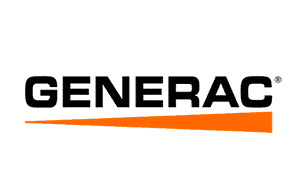
Average cost
Pros
- Comes with full-service home energy solutions
- Industry leading power
- Scalable system
Cons
- No protection against reductions in power capacity
Unlike our top two solar battery manufacturers, Generac doesn’t manufacture solar panels and instead focuses entirely on battery banks and off-grid generators. The Generac PWRCell is a widely-known product, most notable for its high storage capacity and add-on options, like the PWRGenerator and the PWRManager.
We recommend Generac solar batteries for anyone who’s looking for a one-stop shop for off-grid power, especially if you want a high-capacity battery with an outstanding efficiency rating.
What We Like
As mentioned above, Generac stands out because of its efficiency rating and its expandability with add-on products.
The PWRCell from Generac has an industry-leading round-trip efficiency of 96.5%. That means it will help you make the most of the solar energy you collect with your panels and can provide maximum power for your home in blackout or low-sun conditions. This makes it ideal for areas without net metering and solar customers who see low-sun conditions often.
Generac also makes a handful of solar battery add-on products to manage power more efficiently and maximize your off-grid power. It has specialized in generators for years before entering the solar industry, so its gas generators make great add-ons to your battery options. The PWRManager also lets you maintain total control over your off-grid system to conserve power for where you need it most.
What We Don’t Like
The biggest downside to the Generac PWRCell, in our opinion, is that the maximum capacity with batteries in series is just 36 kWh. That means you won’t be able to last too long off-grid, even if you max out the capacity.
The other downside to the PWRCell is the DoD, sitting at just 84%. This is below the industry average of 90%, which means you’re paying for capacity you ultimately can’t use to power your home.
Read our full review of Generac for more information.
Solar Battery Options
Generac has just one option available right now, which is the PWRCell. The company’s sole battery has an above-average capacity of up to 18 kWh if you opt for the larger battery. It also comes in a smaller size of just 9 kWh. The performance specs, including the continuous output of 8 kWh, make it a great option for homes with a high energy demand.
We’ll include some information on this battery in the table below for easy comparison to other brands on this list.
| Generac PWRCell | |
| Solar Energy Storage (Per Battery) | 9–18 kWh |
| Total Capacity (In Series) | 36 kWh |
| Total Cost | $10,000 |
| Cost Per kWh | $1,100 |
| Continuous Power Output | 8 kWh |
| Peak Power Output | 10 kWh |
Warranty Information
Generac’s warranty is right around average for the solar battery industry. It protects the product and battery efficiency for 10 years and guarantees a remaining efficiency of 70% at the end of the warranty term.
Installation Options
Generac partners with a huge number of certified installers to keep its products widely available across the country. Most solar customers in the U.S. should have no problem finding a local installer that carries Generac products. However, it is less prevalent in the industry than some other top options, including the Powerwall and SunPower’s battery, which we’ll discuss next.
Facts and Figures: Generac
| EcoWatch Rating |
|---|
| Average Cost ($-$$$$$) |
| 4.5 |
| $$$ |

LG

Average cost
Pros
- Durable quality
- Top-tier electronics company
- Highly efficient
- Work in multiple configurations
Cons
LG has been developing solar batteries for years, and since it exited the solar panel manufacturing industry, it’s now an even more trusted name for batteries. LG batteries come in a wide range of sizes, meaning it’s easy to customize your solar storage solution based on your energy needs and expectations in blackout conditions.
We recommend the LG battery for anyone who just wants emergency backup power and doesn’t need to maximize their storage capacity.
What We Like
LG offers three lines of solar batteries in different sizes and power outputs, allowing solar customers to customize their storage systems based on their individual needs.
The performance specifications of the LG batteries are quite good, and most are above average. That includes a high round-trip efficiency rating of 94.5% and power output ratings of 5 kWh and 7 kWh (continuous and peak, respectively).
The LG batteries don’t do well set up in series, so they’re not a great option for solar customers who want high capacities for total peace of mind through power outages. However, the price per kWh is low, and the minimum battery size is well below average for those looking for emergency power only.
What We Don’t Like
The biggest drawback to the LG batteries, in our opinion, is the efficiency loss you’ll experience over time. The warranty coverage is for the standard 10 years, but only 60% of your original battery capacity is guaranteed to remain at that time, so these batteries lose efficiency more rapidly than most other options.
Additionally, the maximum capacity you can have in series is only 19.6 kWh. That may not be enough for some homes to remain off-grid for long, even with an islanding inverter that allows your panels to recharge your batteries.
Read our full review of LG for more information.
Solar Battery Options
One upside of going with LG for your battery storage system is that it has a few different options available, depending on your capacity and output needs.
- LG Chem RESU: The original RESU battery has a low voltage of 48V, so it comes with the lowest power output of the three. The continuous and peak outputs can be as low as 3 kWh and 3.3 kWh, respectively. That means they’re best for emergency backup only. These also come in three capacities, ranging from 6.5 kWh up to 13 kWh. As such, they provide the most customization within the LG lineup.
- LG Chem RESU-H: The RESU-H series has a higher voltage, which results in higher outputs. The 5.0 kWh continuous power output and 7.0 peak output mean this battery is suitable for powering your entire home, even if you have above-average rates of consumption. These batteries aren’t compatible with as many inverter brands as the base RESU model, so it might be harder to retrofit into an existing solar array.
- LG Chem RESU Prime: The RESU Prime is the most capable of the three, with a continuous power output of 7 kWh and a peak output of 11 kWh. This is the best option from LG if you’re looking to maintain full power in a blackout and have an above-average rate of consumption. This battery performs slightly better in the cold, as well, so it might be a better option for colder climates. Finally, the capacity is the largest of the three, reaching up to 16 kWh.
The table below provides a quick side-by-side view of the three battery options from LG.
| LG RESU | LG RESU-H | LG RESU Prime | |
| Storage Capacity (Per Battery) | 6.5–13 kWh | 6.5–9.8 kWh | 10–16 kWh |
| Total Capacity (In Series) | 26 kWh | 19.6 kWh | 32 kWh |
| Total Cost | $6,630–$13,260 | $6,630–$1,000 | $10,200–$16,320 |
| Cost Per kWh | $1,020 | $1,020 | $1,020 |
| Continuous Power Output | 3.0–5.0 kWh | 3.5–5.0 kWh | 5.0–7.0 kWh |
| Peak Power Output | 3.5–7.0 kWh | 5.0–7.0 kWh | 7.0–11.0 kWh |
Warranty Information
LG’s battery warranty lasts for 10 years, which is average. Unfortunately, it only guarantees that your batteries will retain 60% of their original efficiency, which is below the industry standard of 73%.
Installation Options
LG is another manufacturer that patterns with a wide range of installers. Its network isn’t as large as what you’ll find from Tesla or SunPower, but most residents should be able to find a provider that carries LG products and is certified to install them.
Additionally, LG RESU batteries can be installed even if you don’t have solar modules on your roof, so these batteries can be used like traditional electric generators.
Facts and Figures: LG
| EcoWatch Rating |
|---|
| Average Cost ($-$$$$$) |
| Solar Services |
| 5 |
| $$$ |
| Solar Panels, Solar Batteries |
What Should You Look for When Looking for Solar Batteries?
A lot of solar customers choose the Tesla Powerwall just because it’s the product they’ve heard about most often, and others may get shoehorned into a specific battery based on what their installer carries. We recommend choosing your battery carefully, even if it means installing panels with a different solar company.
Below are three things we’d specifically look for in a solar battery, along with a brief explanation as to why we think each is so important.
- Battery capacity: The storage capacity of your battery or batteries is a crucial thing to dial in. Oversizing your system means you’ll pay far more than you need to for backup power. Undersizing your system means you’ll only be able to power your home—or certain items in your home—for a short amount of time during an outage. It’s also important to note that solar batteries are becoming more prevalent as net metering policies decline across the country, as they recently did in California in mid-2024. Without net metering, solar batteries become the only way to maximize solar savings. If you want to make sure you save around the national average — $31,513 — you should make sure your capacity is large enough to offset consumption even when your panels aren’t producing enough to sustain your electricity usage.
- Power output: Most customers forget to consider the continuous and peak power ratings of their batteries. These numbers ultimately determine how many electronics and appliances you can run in your home at once on battery power. A rating that’s too low might not meet your energy demands and could end up damaging your batteries.
- Islanding inverter: A lot of the big-name solar batteries include islanding inverters, but not all of them do. Under normal circumstances, your panels will not provide electricity to your home in the event of a power outage to avoid dangerous currents running through utility lines when workers are restoring power. An islanding inverter lets you separate your photovoltaic (PV) system from the grid entirely so that your panels can recharge your batteries even during an outage. That means you can stay off-grid for much longer than you otherwise would, making the most use of your batteries’ capacity.
Compare the Top-Rated Solar Battery Manufacturers
The solar battery manufacturer you opt for can determine the warranty you get with your equipment, the customer service you’ll experience in the event of a warranty claim, the overall quality and reliability of the battery and more.
Based on the company’s reputation alone, we’d recommend Tesla and SunPower. Tesla is well-known for providing advanced technology, and SunPower is one of the most trusted and reputable companies in the solar industry.
The table below includes a look at how these companies and the ones we’ve reviewed above compare to one another. Keep in mind that these scores are determined using average numbers for each specification we consider if the provider offers more than one battery option.
| Tesla | Panasonic | SunPower | Generac | LG | |
| Capacity (Out of 20) | 20.0 | 20.0 | 15.0 | 15.0 | 5.0 |
| Price (Out of 20) | 18.0 | 15.0 | 18.0 | 15.0 | 15.0 |
| Power & Performance (Out of 25) | 23.0 | 23.0 | 20.0 | 21.0 | 21.0 |
| Warranty (Out of 20) | 15.0 | 14.0 | 13.0 | 13.0 | 14.0 |
| Availability (Out of 10) | 5.0 | 8.0 | 8.0 | 7.0 | 8.0 |
| Battery Type & Sustainability (Out of 5) | 3.0 | 3.0 | 3.0 | 3.0 | 5.0 |
| Total Score (Out of 100) | 84.0 | 82.0 | 77.0 | 73.0 | 69.0 |
Compare the Top-Rated Solar Batteries
In addition to considering the manufacturer of your solar battery, it’s, of course, important to compare the batteries themselves to make sure you get one that meets your needs. Overall, our top recommendations are the Tesla Powerwall (including the Powerwall+, the Powerwall 2 and the Powerwall 3, which is coming out in 2024) and the Panasonic EverVolt. The table below includes a comparison of these batteries and the other options we’ve reviewed above.
| Tesla Powerwall +/2 | Panasonic EverVolt | SunPower SunVault | Generac PWRCell | LG Chem RESU 10-HR | |
| Per Battery Capacity | 13.5 kWh | 17.5 kWh | 13–52 kWh | 9–18 kWh | 10.5 kWh |
| Total Capacity Possible in Series | 135 kWh | 102 kWh | 52 kWh | 36 kWh | 19.6 kWh |
| Price Per Battery | $11,500 | $15,000 | $12,000 | $10,000 | $10,000 |
| Price Per kWh | $851 | $857 | $923 | $1,100 | $1,020 |
| Continuous Power Output | 5.0 kWh | 9.6 kWh | 6.8 kWh | 8.0 kWh | 5.0 kWh |
| Peak Power Output | 7.0 kWh | 12.0 kWh | 10.0 kWh | 10.0 kWh | 7.0 kWh |
| Depth of Discharge (% Usable Capacity) | 100% | 100% | N/A | 84% | 90% |
| Round-Trip Efficiency | 90% | 90% | 85% | 96.5% | 94.5% |
| Warranty Length | 10 years | 10 years | 10 years | 10 years | 10 years |
| Efficiency Remaining At End of Warranty | 70% | 60% | 70% | 70% | 60% |
| Lead Time Issues | Yes | No | No | No | No |
| Available for DIY Installation | No | No | No | Yes | No |
| Available Without Panels | Yes | Yes | Yes | No | Yes |
What Do the Solar Battery Specs Even Mean?
Looking at the battery specifications we’ve mentioned above can quickly get confusing. Not only are there a bunch of specs that vary pretty widely, but it’s also not apparent what each of them even means. Below, we’ll clarify what some of the less obvious specifications above mean and why we feel each is an important consideration.
- Per-battery capacity: The per-battery capacity tells you how much energy storage you get with each battery you install. The lower this number, the lower the barrier to entry into solar batteries as a whole. However, it’s important to consider this number in combination with the per-battery cost to see what you’re paying for each kWh. The SunVault from SunPower provides the highest per-battery capacity of our top picks by far.
- Total capacity in series: Many manufacturers let you install multiple batteries stacked together for greater total energy storage to provide more backup power to your home. The higher this number, the longer your system will be able to maintain power in your home through blackout conditions. Tesla lets you link 10 batteries together in parallel, providing the highest capacity in series of our top battery options — up to 135 kWh. To put that into perspective, the average home in the U.S. consumes 881 kWh per month, which means the Powerwall series could sustain full power for around 5 days, and that’s without any additional input from your panels. With your panels continuing to produce and charge them, you could potentially last indefinitely without power from the grid.
- Price per kWh: The price per kWh is straightforward, but it’s something many solar customers overlook. The cost per battery is important, but the per-kWh price is more important for determining the value you get for your money. The Powerwall Plus has the lowest price per kWh of the options we’ve reviewed.
- Continuous power output: Continuous power rating tells you how much power your battery can continuously put out over long periods. The higher this number, the more likely your battery will be able to provide electricity to your entire home, including all appliances, electronics and even an EV charger. A lower output could mean the battery is only suitable for emergency power in an outage. The Panasonic EverVolt has the highest continuous output of the options above.
- Peak power output: Peak power ratings are similar, but they tell you the highest amount of power your battery can put out without sustaining damage. The higher this number is, the more likely your battery will be to keep up with high demand during blackouts without losing efficiency. Panasonic’s solar battery also scores highest in this category.
- Depth of discharge (DoD): This spec tells you how much of the battery’s storage can actually be used to power your home. The closer this number is to 100%, the more usable capacity you’ll have per kWh indicated in the battery’s nominal capacity. For example, a 100% DoD on a 10 kWh battery means you have 10 kWh of storage. A 90% DoD on that same battery means you effectively only have 9 kWh of storage. The batteries from Tesla and Panasonic have the highest DoD at 100%.
- Round-trip efficiency: Round-trip efficiency tells you how much of the solar power being routed to your battery will actually be available for storage. All batteries lose some of the energy generated by your panels, but the higher this number is, the less energy you’ll lose in the transition to storage. Higher efficiency ratings are best in areas where energy costs are high and where you don’t have access to net energy metering (NEM), as they will help maintain more of the power your panels generate to offset utility bills. The Generac PWRCell has one of the highest round-trip efficiency ratings in the industry at 96.5%.
What Are the Benefits of Solar Batteries?
Solar batteries are expensive — usually adding between $10,000 and $20,000 to an already high solar installation cost of $29,970, on average, in the U.S. — and can often double your solar installation costs if you want full backup capabilities for your home. As such, many solar customers wonder if solar batteries are worth it. Below are a few of the most significant benefits they provide:
- Backup power during outages
- Effective net metering
- Energy independence
- Reduced carbon footprint
- Improved home value
We’ll explain each of these benefits in the following sections.
Backup Power During Outages
The most obvious benefit you’ll see from your solar batteries is the backup power they provide during blackouts. Having a solar battery or series of batteries installed gives you peace of mind that you’ll be able to maintain emergency power—for things like refrigerators, freezers and medical equipment—no matter what happens.
PV batteries are especially beneficial in areas where extreme weather is common. If you live in a state where hurricanes, tropical storms, tornadoes or other severe conditions frequently lead to blackouts, a backup power option that you can charge for free with your panels is a must-have.
Effective Net Metering
The biggest benefit to having solar panels for many solar customers is the savings on energy bills, but panels can’t always offset your electricity consumption. Panels see reduced or eliminated production on cloudy days and at night, which means you’ll have to pay the retail rate for any consumption at that time, provided you don’t have access to net energy metering.
Solar batteries provide effective NEM since you can store energy for later use if your panel production ever drops below your energy demands. Batteries can save thousands of dollars over their lifetime, especially if your state or utility company doesn’t offer net energy metering and you live in an area with above-average electricity rates.
It’s worth mentioning that California recently pushed out net metering 3.0, which decreased the credit rate for exported electricity. This is a big deal because California is the #1 state for solar in the country by a decent margin, so its policies are influential, to say the least. The likelihood is that the decreased net metering trend will continue in other states as well, which will make the effective net metering you get from solar batteries all but necessary to see a fast solar panel payback period and decent net profit from going solar.
Energy Independence
Since solar batteries provide effective NEM, they can often mean total energy independence if you also have panels installed.
That not only means that you don’t have to rely on a utility provider to deliver electricity, but, more importantly, that you don’t have to deal with increasing energy prices. Electricity costs in the U.S. have increased nearly 10% over the last year alone, according to the Bureau of Labor Statistics (BLS).
Energy prices are expected to continue to go up in the future, too. Your batteries will save you even more than expected because they offset energy consumption for which you would otherwise pay increasing prices.
Reduced Carbon Footprint
Another huge benefit of going solar is reducing your carbon footprint since most energy producers rely heavily on burning fossil fuels to generate the power they distribute. If you just have solar panels installed, your consumption on cloudy days, at night or during times of high demand will still rely on fossil fuels.
When you install a solar battery system, you’re far more likely to become totally independent from your power company. That means you’re contributing less to fossil fuel consumption and pollution, and you’re further reducing your CO2 emissions.
Improved Home Value
Finally, installing panels alone is estimated to boost your home value by around 4.1%. This is substantial, but most buyers are likely to see the increased benefits of your home being equipped with backup power as well. That will likely lead to buyers being willing to pay even higher prices for your property.
How Do Solar Batteries Work?
Solar batteries work just like other lithium batteries, except they get recharged most of the time with energy from your solar panels.
In a DC-coupled battery, the DC power coming from your panels creates a chemical reaction inside the battery, causing the lithium ions to release electrons. In an AC-coupled battery, the DC solar energy is converted in an inverter to AC power, and then excess energy is converted back to DC in another inverter. When the battery is called on for power, the energy is inverted a third time to AC power to be used in the home.
Generally speaking, DC-coupled batteries are more efficient than AC-coupled batteries because the energy only needs to be converted once, as opposed to three times. This reduces the amount of electricity lost in conversion.
Those free electrons then travel back and forth between the positive cathode and negative anode, depending on which direction energy is moving. The chemical reaction inside the battery is how those free electrons get stored for later use.
4 Types of Solar Batteries
There are four different kinds of solar batteries available for residential use:
- Lithium-ion batteries
- Flow batteries
- Lead-acid batteries
- Nickel-cadmium (Ni-Cd) batteries
We’ll explain the differences between each of these below.
Lithium-Ion Solar Batteries
Lithium-ion is the most prominent battery technology in the industry. You’ll often see these batteries listed as “lithium iron phosphate” batteries, LFP or LiFePO 4.
LFP batteries boast the highest battery capacities and have the longest-lasting battery lifespan of all of the options. They also require virtually no maintenance. These are best for solar customers looking for high performance, durability and longevity.
LFP batteries are more expensive than most other types of solar storage systems, which is the biggest downside.
Flow Solar Batteries
Flow batteries are a newer technology being used in the industry. They contain an electrolyte liquid that flows back and forth between storage tanks, which causes a similar reduction-oxidation (redox) process that you see in a lithium-ion battery. Flow batteries are also maintenance-free, and they come with the lowest risk of fire.
Flow batteries all have a 100% DoD, so you don’t lose any of the battery’s nominal capacity. They’re also some of the most durable options available.
However, they’re currently the most expensive since they’re an emerging technology, and the physical size of the battery needs to be large to reach the capacity and power output of lithium-ion batteries.
At this point, we only recommend flow batteries for solar customers who only want emergency backup power and are looking for a long battery lifespan.
Lead-Acid Solar Batteries
Lead-acid batteries are deep cycle batteries that are the most affordable option, primarily because they’ve been around the longest, so the production process is dialed in. The materials are also more affordable than lithium.
Lead-acid batteries are reliable and affordable, but they have a low DoD and a shorter battery lifespan than most other options. They also need regular maintenance and have some installation restrictions due to the potential for leaking.
We recommend these batteries for solar customers who are looking to keep upfront costs to a minimum.
Nickel-Cadmium Solar Batteries
Nickel-cadmium batteries are less prevalent than they used to be because cadmium is a toxic element. Most solar battery manufacturers have abandoned this technology in favor of lithium-ion.
Still, Ni-Cd batteries have excellent durability and are the best suited to operate in extreme temperatures. We recommend staying away from these unless you have no other option based on the climate where you live.
Nickel-manganese-cobalt (NMC) batteries also exist, but the manganese is also toxic, so these are also not prevalent in the industry.
Bottom Line: What’s the Best Solar Battery for You?
There isn’t one single battery that will be best for every solar customer. We suggest you consider a few different performance specifications when choosing a battery, including the per-battery and total capacity, the price per kWh, the power output, the warranty coverage and more.
Our top recommendations are the Tesla Powerwall + or the Tesla Powerwall 2, which we believe live up to the hype. These are the most popular solar batteries, though, and it might be overpowered for your home, depending on your expectations. However, the high capacity might be ideal for you if you live in an area without net metering, as batteries help boost your solar panel value, pay off your equipment more quickly and secure a net profit from your system.
As such, we recommend getting a few different quotes that include an array of solar battery options to make sure you’re getting the one that’s best suited for you. You can use the tool below to get multiple free solar battery quotes from providers in your area.
Methodology: How We Reviewed the Best Solar Batteries
We looked at every major solar battery available in the industry and compared them all based on six main categories and 17 individual metrics. We then weighted each spec, keeping in mind how impactful it would be to your experience. We’ll explain our six rating categories below.
- Battery capacity (20%): We first consider the per-battery capacity and the total capacity you can install in series. Higher capacities mean more backup power for your home, which can save you more money and provide greater peace of mind during blackouts.
- Price (20%): Cost is always going to be important, especially when batteries often cost close to $10,000 and are typically installed alongside a $20,000+ solar array. We consider the cost per battery for accessibility and the cost per kWh for overall value.
- Power and performance (25%): We look at five different performance specifications to find the solar batteries with the greatest power output to meet high energy demands and the highest efficiency to make your solar electricity go further.
- Warranty (20%): Most solar batteries have a 10-year warranty, but we also look at the efficiency degradation of each option to gauge longevity and durability.
- Availability (10%): Batteries with known lead time issues get ranked a bit lower than those with high availability. We also give extra points to batteries that can be installed by DIYers and those that can be installed independently of solar panels.
- Battery type and sustainability (5%): Finally, we rank each manufacturer based on the battery types they offer and the overall sustainability of the company. Lithium-ion batteries get the highest rankings, as they’re usually best for homeowners, and companies get extra points if they manufacture their products in the U.S.
FAQs: Best Solar Batteries
Below, we’ll answer some of the questions we see most often about solar batteries and their specifications.
In our opinion, Tesla manufactures some of the best solar batteries in the industry. The Powerwall+ boasts some impressive performance specs and technology, and it’s highly affordable on a per-kWh basis. With that being said, it’s not right for everyone. We also recommend looking at batteries from Panasonic, SunPower, Generac and LG.
In our opinion, yes. The Powerwall has impressive power output and capacity ratings that can save you quite a lot of money on your electric bills if you don’t have access to net energy metering. It also provides peace of mind through power outages, as each is equipped with an islanding inverter to keep you fully off-grid while you recharge with your panels during blackouts.
A solar battery backup is a battery that gets installed alongside your panels. It stores solar power for use during outages so that you can maintain electricity. They can also provide power for your home on cloudy days or at night, potentially helping you save money on electricity if you don’t have access to a net energy metering program.
Yes, absolutely. The solar batteries available all differ in capacity, the maximum number of batteries you can connect in parallel, their power output, efficiency, degradation, longevity and more. We recommend the Tesla Powerwall+ for most solar customers, but other options might suit you better, especially if you only need emergency backup power.
Related Solar Energy Guides
- California
- Texas
- New Jersey
- Nevada
- Florida
- New York
- Utah
- Michigan
- Hawaii
- Minnesota
- Louisiana
- Arkansas
- Montana
- Georgia
- North Carolina
- South Carolina
- Virginia
- Idaho
- Indiana
- Ohio
- New Hampshire
- Vermont
- Alaska
- North Dakota
- South Dakota
- Alabama
- Wyoming
- Nebraska
- Kansas
- Mississippi
- Tennessee
- New Mexico
- Colorado
- Oklahoma
- Missouri
Comparing authorized solar partners
-
- Price-match guarantee
- Sleek, efficient and durable solar panels
- Best solar battery on the market
- Some reported issues with customer service
- Customer service varies by local dealer
CBest Technology
Having trouble deciding? Click below and use our process to receive multiple quotes instead:

 233k
233k  41k
41k  Subscribe
Subscribe 
